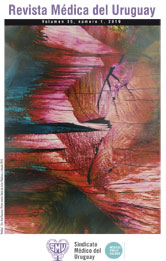Evaluación del seguimiento radiográfico para desplazamiento de cadera en pacientes con parálisis cerebral en el Centro Hospitalario Pereira Rossell
Resumen
Introducción: la luxación de cadera es una complicación severa en pacientes con parálisis cerebral (PC), sobre todo en pacientes incluidos en el sistema de clasificación de la función motora gruesa (GMFCS, por su sigla en inglés) III-V. Para su identificación son necesarias radiografías de pelvis.
Objetivos: evaluar el seguimiento radiográfico en estos pacientes y la detección precoz de esta complicación en nuestro hospital.
Material y método: se revisaron historias clínicas y radiografías de 17 pacientes GMFCS III-V, entre 2 y 8 años de edad al momento de la radiografía de pelvis índice, midiendo el porcentaje de migración (PM) de cadera de acuerdo al índice de Reimer, el ángulo cérvico-diafisiario y calculando el CPUP Score de cada cadera. Evaluamos el control radiográfico al año o posteriormente a esa fecha, y de no haber sido así, se citaría a los pacientes a control radiológico para detectar las caderas con riesgo migratorio elevado.
Resultados: de los 17 pacientes evaluados, 3 (18%) tuvieron una nueva radiografía de pelvis al año; 6 (35%) pacientes la tuvieron posteriormente al año, y antes de la fecha de control designada, 7 (41%) pacientes nunca fueron controlados, citándose para nueva radiografía en 2018. Un paciente (6%) se perdió en el seguimiento. Un paciente presentó una cadera con riesgo alto (CPUP Score 50%-60%), el resto tuvo PM dentro de rangos normales.
Conclusiones: pocos pacientes con PC GMFCS III-V tuvieron un seguimiento radiográfico anual. Los monitoreados posteriormente no mostraron progresión de esta condición. El resultado de este estudio y la literatura respaldan la introducción de un programa de vigilancia en nuestro hospital.
Citas
(1) Graham HK, Rosenbaum P, Paneth N, Dan B, Lin JP, Damiano DL, et al. Cerebral palsy. Nat Rev Dis Primers 2016; 2:15082.
(2) Hägglund G, Andersson S, Düppe H, Lauge-Pedersen H, Nordmark E, Westbom L. Prevention of hip dislocation in children with cerebral palsy. The first ten years experiences of a population-based prevention programme. J Bone Joint Surg Br 2005; 87(1):95-101.
(3) Pruszczynski B, Sees J, Miller F. Risk factors for hip displacement in children with cerebral palsy: systematic review. J Pediatr Orthop 2016; 36(8):829-33.
(4) Reimers J. The stability of the hip in children. A radiological study of the results of muscle surgery in cerebral palsy. Acta Orthop Scandin Suppl 1980; 184:1-100.
(5) Hermanson M, Hägglund G, Riad J, Rodby-Bousquet E, Wagner P. Prediction of hip displacement in children with cerebral palsy. Bone Joint J 2015; 97-B(10):1441-4.
(6) Hermanson M, Hägglund G, Riad J, Wagner P. Head-shaft angle is a risk factor for hip displacement in children with cerebral palsy. Acta Orthop 2015; 86(2):229-32.
(7) Givon U. Management of the spactic hip in cerebral palsy. Curr Opin Pediatr 2017; 29(1):65-9.
(8) Hägglund G, Alriksson-Schmidt A, Lauge-Pedersen H, Rodby-Bousquet E, Wagner P, Wastbom L. Prevention of dislocation of the hip in children with cerebral palsy: 20-year results of a population-based prevention programme. Bone Joint J 2014; 96-B(11):1546-52.
(9) Elkamil Al, Andersen GL, Hägglund G, Lamvik T, Skranes J, Vik T. Prevalence of hip dislocation among children with cerebral palsy in regions with and without a surveillance programme: a cross sectional study in Sweden and Norway. BMC Musculoskel Dis 2011; 12:284.
(10) Kentish M, Wybter M, Snape N, Boyd R. Five-year outcome of state-wide hip surveillance of children and adolescents with cerebral palsy. J Pediatr Rehabil Med 2011; 4(3):205- 17.
(11) Hägglund G. Radiographic follow-up in CPUP to prevent hip dislocation. 2013. Disponible en: http://cpup.se/wp-content/uploads/2013/07/CPUPprevent_hip_dislocation20130210.pdf. Consulta: 24 setiembre 2018.
(12) Rehbein I. Análisis de los procedimientos quirúrgicos ortopédicos realizados en niños con parálisis cerebral en relación con la edad y función motora gruesa. Monografía Postgrado Montevideo: Traumatología y Ortopedia, Facultad de Medicina-UdelaR, 2018.
(13) Palisano R, Rosenbaum P, Walter S, Russell D, Wood E, Galuppi B. Development and reliability of a system to classify gross motor function in children with cerebral palsy. Dev Med Child Neurol 1997; 39(4):214-23.
(14) Gainsborough M, Surman G, Maestri G, Colver A, Cans C. Validity and reliability of the guidelines of the surveillance of cerebral palsy in Europe for the classification of cerebral palsy. Dev Med Child Neurol 2008; 50(11):828-31.
(15) Hägglund G, Lauge-Pedersen H, Wagner P. Characteristics of children with hip displacement in cerebral palsy. BMC Musculoskeletal Disord 2007; 8:101.
(16) Hägglund G, Lauge-Pedersen H, Persson M. Radiographic threshold values for hip screening in cerebral palsy. J Child Orthop 2007(1):43-7.
(17) AppInConf AB. CPUP Hip Score APP. Lund, Suecia: AppInConf AB, 2019. Disponible para IPhone y Android.
(18) Southwick WO. Osteotomy through the lesser trochanter for slipped capital femoral epiphysis. J Bone Joint Surg Am 1967; 49(5):807-35.
(19) Hermanson M, Hägglund G, Riad J, Rodby-Bousquet E. Inter-and intra-rater reliability of the head-shaft angle in children with cerebral palsy. J Child Orthop 2017; 11(4):256-62.
(20) Craven A, Pym A, Boyd RN. Reliability of radiologic measures of hip displacement in a cohort of preschool- aged children with cerebral palsy. J Pediatr Orthop 2014; 34(6): 597-602.
(21) Faraj S, Atherton WG, Stott NS. Inter- and intra-measurer error in the measurement of Reimer’s hip migration percentage. J Bone Joint Surg Br 2004; 86(3):434-7.
(22) Gordon GS, Simkiss DE. A systematic review of the evidence for hip surveillance in children with cerebral palsy. J Bone Joint Surg Br 2006; 88(11):1492-6.
(23) Wynter M, Gibson N, Kentish M, Love S, Thomason P, Kerr Graham H. The consensus statement on hip surveillance for children with cerebral palsy: australian standards of care. J Pediatr Rehabil Med 2011; 4(3):183-95.














